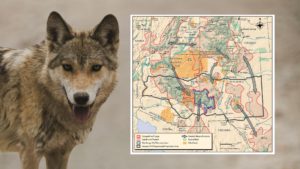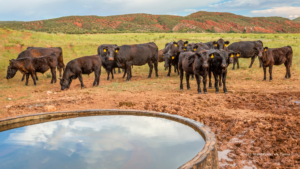For Immediate Release March 28, 2025
Contacts:
Claire Musser, Grand Canyon Wolf Recovery Project, 928-202-1325 claire@gcwolfrecovery.org
Nico Lorenzen, Wild Arizona, 520-289-0147, nico@wildarizona.org
Jacqueline Covey, Defenders of Wildlife, 630-427-7164, jcovey@defenders.org
Regan Downey, Wolf Conservation Center, 914-763-2373, regan@nywolf.org
Greta Anderson, Western Watersheds Project, 520-623-1878, greta@westernwatersheds.org
Kirk Robinson, Western Wildlife Conservancy, 801-468-1535, kirk@westernwildlifeconservancy.org
Female Mexican gray wolf 2996 is returning to suitable wolf habitat near Mount Taylor
ALBUQUERQUE, N.M. – Female Mexican gray wolf 2996, named “Ella” by schoolchildren, has peacefully wandered north of Interstate 40 in New Mexico toward Mount Taylor, an area of pristine habitat teeming with wildlife, including large herds of elk that range from its northeastern foothills all the way to the plateau of Mount Taylor. This area almost certainly would have been home to wolves for millennia before they were wiped out by humans. In fact, she’s traveling quite close to an area known as “Lobo Canyon,” suggesting the appropriateness of this landscape for Mexican wolves.
“Ella is not just a number—she’s a sentient being, a bold young wolf charting her own path and showing us that wolves are the true agents of their recovery. By dispersing north of I-40, she’s proving that suitable, wild habitat still exists where wolves once thrived,” said Claire Musser, the executive director of the Grand Canyon Wolf Recovery Project. “Each wolf carries unique knowledge, instincts, and personality—traits essential to building strong, resilient packs. We need all of them, and they need the freedom to roam.”
“She is the third female wolf in three years to make the journey northward toward Colorado, guided by instinct outside the arbitrary boundaries of the Experimental Population Area, and we would do well to trust that instinct,” said Craig Miller, Defenders of Wildlife senior Arizona representative. “She is a remarkable testament to her ancestors that once roamed from Canada to Mexico, we hope her offspring can roam again one day.”
“Twenty-seven years ago this week, the wilds of the southwest were once again greeted with the howls of Mexican gray wolves. How exciting that as we honor this anniversary, we’re also celebrating another milestone – yet another courageous wolf is proving that wolves belong north of I-40,” said Regan Downey, director of education at the Wolf Conservation Center.
In a move applauded by conservationists, the U.S. Fish and Wildlife Service has indicated there are no plans to capture her at this time.
“This brave loba, and every wild wolf, is essential to the success of the recovery effort,” said Greta Anderson, deputy director of Western Watersheds Project. “We are glad that the U.S. Fish and Wildlife Service is taking a ‘hands off’ approach to Ella. Long may she run!”
“True recovery of the endangered Mexican wolf will require allowing them to expand their range,” said Kirk Robinson, executive director of Western Wildlife Conservancy. “Insisting on an artificial boundary that wolves must not cross makes no sense.”
“Mexican gray wolves consistently cross Interstate 40 only to be dragged back within an illusory management delineation. Lobos will orient themselves toward habitat that best matches what they need. With the vast majority of our landscapes bereft of large carnivores who are critical for ecosystem resilience we must ask ourselves, is an interstate the best way to determine where wolves should live or do the wolves have a better nose for such things? Ella clearly has her own answer and we’d be wise to let her roam.” Nico Lorenzen, Conservation and Wildlife Associate with Wild Arizona.
Mount Taylor is not only excellent lobo habitat; the area is also sacred land to Navajo, Acoma, Laguna, Hopi, Zuni, and other Indigenous peoples. The area holds about 1000 cultural sites and has a rich cultural heritage and ceremonial importance to many people.
Background on Mexican Gray Wolves:
The lobo, or Mexican gray wolf, is the smallest, most genetically distinct, and one of the rarest subspecies of the gray wolf. These native southwestern wolves were listed under the Endangered Species Act in 1976 after being eradicated in the wild. Reintroduction efforts began in 1998, but conservation efforts have suffered without the implementation of recommended recovery actions.
For years, scientists have recommended to the Service that there be three subpopulations of at least 200 wolves each (with a minimum of 750 total), spread throughout the southwestern United States, including areas like the Grand Canyon Ecoregion and the Southern Rockies (Carroll et al. 2006; Wayne and Hedrick 2011; Carroll et al. 2014; Hendricks, et al. 2016). Scientists warn that this metapopulation structure and geographic distribution are imperative to the recovery of Mexican wolves. Unfortunately, we are still far short of this scientific recommendation.
Learn more at www.mexicanwolves.org.
###






